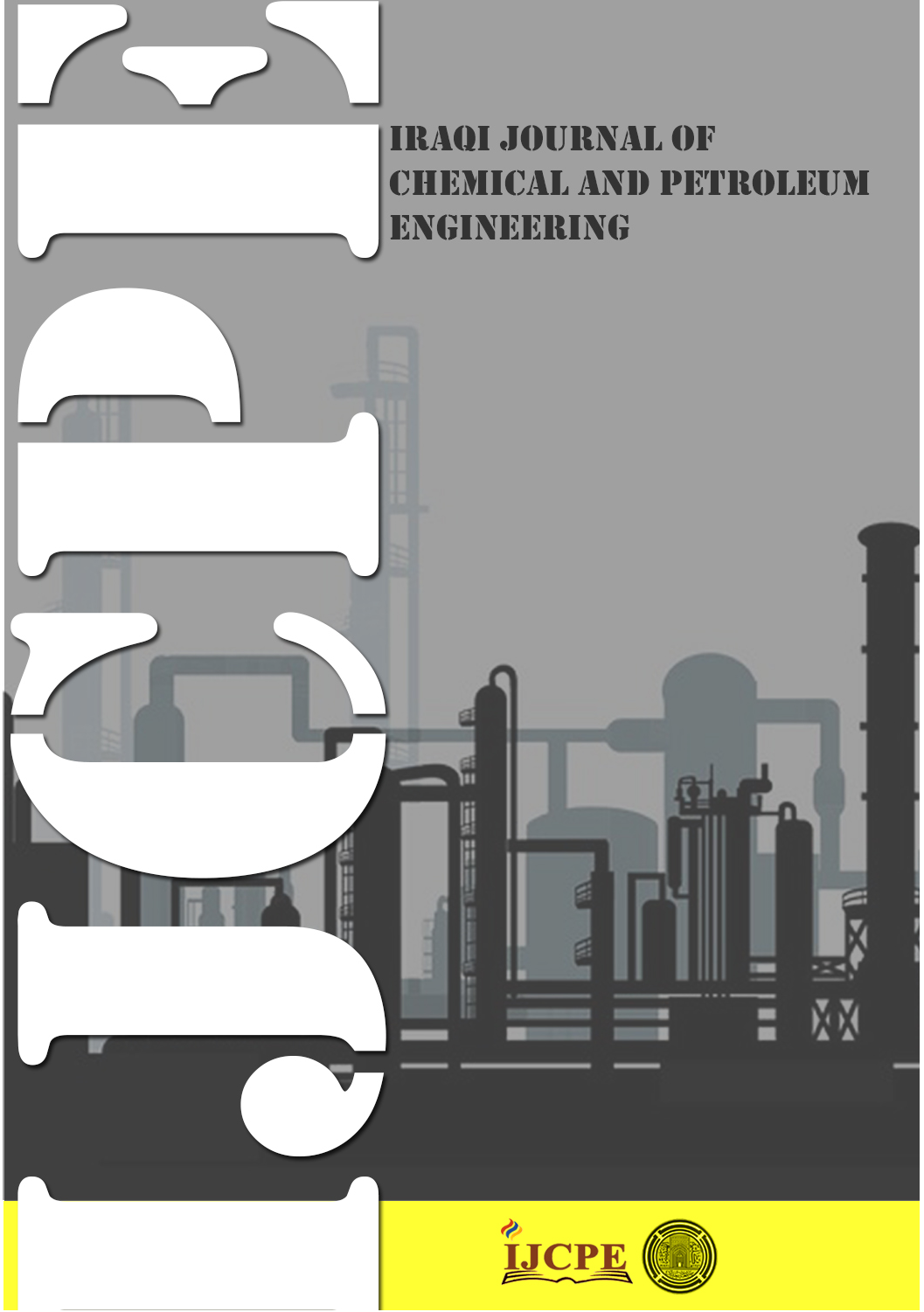Evaluation of petrophysical properties using well logs of Khasib formation in east Baghdad oil field, central area
DOI:
https://doi.org/10.31699/IJCPE.2025.2.14Keywords:
petrophysical properties; analysis of well logs; carbonate reservoir; Khasib formation; east Baghdad oilfield; IP softwareAbstract
The assessment of petroleum characteristics through well log analysis has always been essential for identifying and evaluating hydrocarbon-bearing zones. This study presents a comprehensive re-evaluation and correction of five well log data sets from Khasib formation which is the primary reservoir in the East Baghdad oil field (10 kilometers east of Baghdad City). The corrected data sets were utilized to calculate key parameters, including water saturation, porosity, lithology, and shale volume. Lithology was determined using M-N cross-plots and neutron-density analysis, which showed that the Khasib formation mainly consists of limestone, with calcite as main mineral components and minor amounts of dolomite. Shale volume was assessed using both single and dual shale indicators. The three main logs of porosity neutron, density, and sonic logs were used for computing the porosity. Then, Archie equation was employed to determine water saturation. To verify the accuracy of the computation, a comparison between the results and the available core data was conducted, which indicated that porosity values ranged from 0.143 to 0.212, while water saturation varied from 0.643 to 0.951. In addition, core samples and geological reports confirmed that Khasib formation was clean with minimal shale content.
Received on 26/05/2024
Received in Revised Form on 05/08/2024
Accepted on 10/08/2024
Published on 30/06/2025
References
[1] N. Hurley et al., “Quantification of Vuggy Porosity in a Dolomite Reservoir from Borehole Images and Core, Dagger Draw Field, New Mexico,” in Annual Technical Conference and Exhibition, New Orleans, Louisiana, 1998. https://doi.org/10.2118/49323-MS
[2] S. Ehrenberg, P. H. Nadeau. “Sandstone vs. carbonate petroleum reservoirs: A global perspective on porosity-depth and porosity-permeability relationships.” American Association of Petroleum Geologists, vol. 89, no. 4, pp. 435- 445, 2005. https://doi.org/10.1306/11230404071
[3] F. Aminzadeh, S. N. Dasgupta. “Geophysics in Drilling.” Developments in Petroleum Science, vol. 60, pp. 223-246, 2013. https://doi.org/10.1016/B978-0-444-50662-7.00008-1
[4] S.S. Zughar, A.A. Ramadhan, A.K. Jaber. “Petrophysical Properties of an Iraq Carbonate Reservoir Using Well Log Evaluation.” Iraq Journal of Chemical and Petroleum, vol. 21, no. 1, pp.53-59, 2020. https://doi.org/10.31699/IJCPE.2020.1.8
[5] M. S. Al-Jawad, K. A. Kareem. “Geological Model of Khasib Reservoir- Central Area/East Baghdad Field,” Iraqi Journal of Chemical and Petroleum Engineering, vol. 17, no. 3, pp. 1-10, 2016. https://doi.org/10.31699/IJCPE.2016.3.1
[6] B. Al-Qayim, F. Al-Saadoni, A. Al-Biaty, "Diagenetic Evolution of The Khasib Formation East Baghdad Oil Field," Iraqi Geological Journal, vol.26, no.1, pp. 56- 72, 1993.
[7] L.A. Jameel, F.S. Kadhim, H.I. Al-Sudani. “Petrophysical Properties of Khasib Formation in East Baghdad Oil Field Southern Area.” Iraqi Journal of Chemical and Petroleum Engineering, vol. 21, no. 4, pp. 41-48, 2020. https://doi.org/10.31699/IJCPE.2020.4.5
[8] A.A. Suhail, M.H. Hafiz, F.S. Kadhim. “Petrophysical Properties of Nahr Umar Formation in Nasiriya Oil Field.” Iraqi Journal of Chemical and Petroleum Engineering, vol. 21, no. 3, pp. 9-18, 2020. https://doi.org/10.31699/IJCPE.2020.3.2
[9] K.H. Jassim, J.A. Al-Sudani. “Re- evaluation of Petrophysical Properties in Yammama Formation at Nasiriya Field.” Iraqi Journal of Chemical and Petroleum Engineering, vol. 20, no. 3, pp. 59-66, 2019. https://doi.org/10.31699/IJCPE.2019.3.8
[10] E. Frost Jr, “Method for estimation of bulk shale volume in a real-time logging-while-drilling environment.” United States of America Patent US 9,551,213 B2, 24 Jan 2017.
[11] A.M. Al-Heeti, O.F. Al-Fatlawi, M.M. Hossain. “Evaluation of Mishrif Formation Using an Advanced Method of Interpretation.”.” Iraqi Journal of Chemical and Petroleum Engineering, vol. 24, no. 2, pp. 41-51, 2023. https://doi.org/10.31699/IJCPE.2023.2.5
[12] G. Asquith, D. Krygowski, C. Gibson, “Basic well log analysis.” American Association of Petroleum Geologists, vol. 16, no.2, pp.13-21, 2004.
[13] M.M. Smith, Y. Hao, L.H. Spangler. “Validation of a reactive transport model for predicting changes in porosity and permeability in carbonate core samples,” International Journal of Greenhouse Gas Control, vol. 90, p. 102797, 2019. https://doi.org/10.1016/j.ijggc.2019.102797
[14] H. Husam, A. Al-Hammedi, E. Ralph. “Application of neural network in the petroleum industry,” SPE/IADC Oil and Gas Conference, Manama, 2019.
[15] Y. Hongyan, W. Xiaolong, W. Zhenliang, Z. Yihuai. “Review of Water Saturation Calculation Methods in Shale Gas Reservoir,” SPE Asia Pacific Oil and Gas Conference and Exhibition, 2018. https://doi.org/10.2118/192115-MS
[16] T.K. Al-Ameri, R.Y. Al-Obaydi. "Cretaceous petroleum system of the Khasib and Tannuma oil reservoir, East Baghdad oil field, Iraq." Arabian Journal of Geosciences, vol.4, pp.915-932, 2011. https://doi.org/10.1007/s12517-009-0115-4
[17] R.A. Hashim, G. M. Farman. “How to Estimate the Major Petro physical Properties: A Review.” Iraqi Journal of Oil and Gas Research, vol. 3, no.1, pp.43-58, 2023. https://doi.org/10.55699/ijogr.2023.0301.1037
[18] A.K. Farouk, A.A. Al-Haleem. “Integrating Petropysical and Geomechanical rock Properties for the Determination of Fracability of the Iraqi Tight Oil Reservoir.” Iraqi Geological Journal, vol. 55, pp. 81-94, 2022. https://doi.org/10.46717/igj.55.1F.7Ms-2022-06-22
[19] L.A. Jameel, F.S. Kadhim, H.I. Sudani. “Geological Model for Khasib Formation of East Baghdad Field Southern Area.” Journal of Petroleum Research and Studies, vol.10, pp.21-35, 2020. https://doi.org/10.52716/jprs.v10i3.327
[20] Z.A. Mahdi, G.M. Farman. “A Review on Model for Evaluating Rock Petropysical Properties.” Iraqi Journal of Chemical and Petroleum Engineering, vol. 24, pp. 125-136, 2023. https://doi.org/10.31699/IJCPE.2023.1.14
[21] B.A. Al-Baldawi. “Evaluating of Petrophysical Properties Using Well Logs of Yamama Formation in Abu Amood Oil Field, Southern Iraq.” Iraqi Geological Journal, vol.54, no.1, pp.67-77, 2021. https://doi.org/10.46717/igj.54.1E.6Ms-2021-05-27
[22] M.H.A. Al-Majid. “Petrophysical Properties Estimation of Euphrates Reservoir in Qayyarah Oil Field Using Core and Well Log Data.” Iraqi Geological Journal, vol.54, no.2, pp.186-197, 2021. https://doi.org/10.46717/igj.54.2E.13Ms-2021-11-29
Downloads
Published
Issue
Section
License
Copyright (c) 2025 The Author(s). Published by College of Engineering, University of Baghdad.

This work is licensed under a Creative Commons Attribution 4.0 International License.













